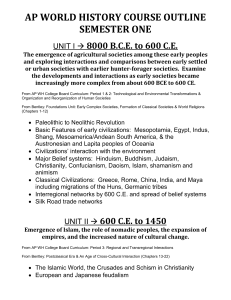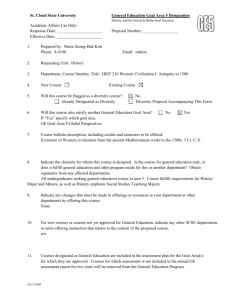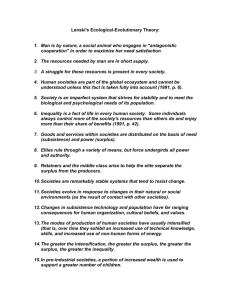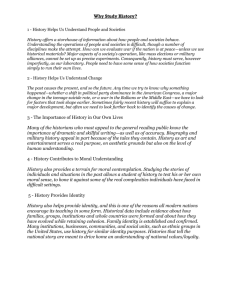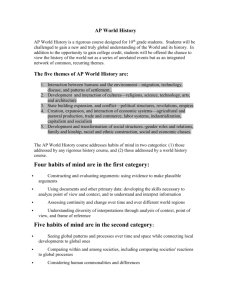APWH Syllabus Revised
advertisement
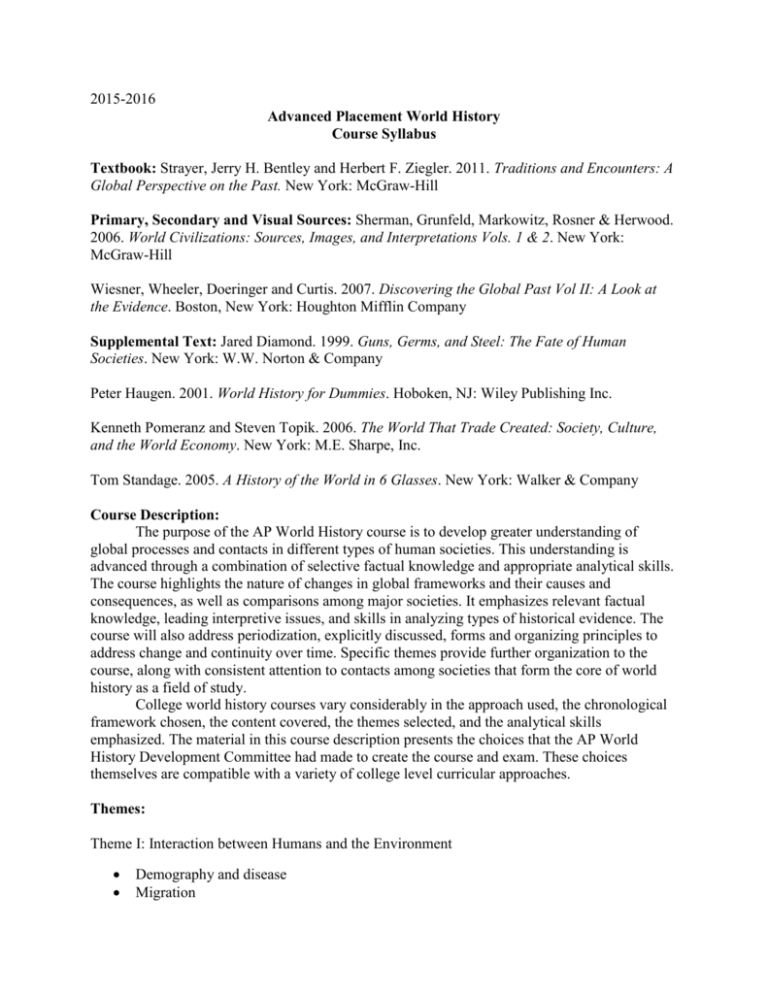
2015-2016 Advanced Placement World History Course Syllabus Textbook: Strayer, Jerry H. Bentley and Herbert F. Ziegler. 2011. Traditions and Encounters: A Global Perspective on the Past. New York: McGraw-Hill Primary, Secondary and Visual Sources: Sherman, Grunfeld, Markowitz, Rosner & Herwood. 2006. World Civilizations: Sources, Images, and Interpretations Vols. 1 & 2. New York: McGraw-Hill Wiesner, Wheeler, Doeringer and Curtis. 2007. Discovering the Global Past Vol II: A Look at the Evidence. Boston, New York: Houghton Mifflin Company Supplemental Text: Jared Diamond. 1999. Guns, Germs, and Steel: The Fate of Human Societies. New York: W.W. Norton & Company Peter Haugen. 2001. World History for Dummies. Hoboken, NJ: Wiley Publishing Inc. Kenneth Pomeranz and Steven Topik. 2006. The World That Trade Created: Society, Culture, and the World Economy. New York: M.E. Sharpe, Inc. Tom Standage. 2005. A History of the World in 6 Glasses. New York: Walker & Company Course Description: The purpose of the AP World History course is to develop greater understanding of global processes and contacts in different types of human societies. This understanding is advanced through a combination of selective factual knowledge and appropriate analytical skills. The course highlights the nature of changes in global frameworks and their causes and consequences, as well as comparisons among major societies. It emphasizes relevant factual knowledge, leading interpretive issues, and skills in analyzing types of historical evidence. The course will also address periodization, explicitly discussed, forms and organizing principles to address change and continuity over time. Specific themes provide further organization to the course, along with consistent attention to contacts among societies that form the core of world history as a field of study. College world history courses vary considerably in the approach used, the chronological framework chosen, the content covered, the themes selected, and the analytical skills emphasized. The material in this course description presents the choices that the AP World History Development Committee had made to create the course and exam. These choices themselves are compatible with a variety of college level curricular approaches. Themes: Theme I: Interaction between Humans and the Environment Demography and disease Migration Patterns of settlement Technology Theme II: Development and Interaction of Cultures Religions Belief systems, philosophies and ideologies Science and technology The Arts and architecture Theme III: State Building, Expansion and Conflict Political structures and forms of governance Empires Nations and nationalism Revolts and revolutions Regional, trans regional, and global structures and organizations Theme IV: Creation, Expansion and Interaction of Economic Systems Agricultural and pastoral production Trade and commerce Labor systems Industrialization Capitalism and socialism Theme V: Gender roles and relations Family and kinship Racial and ethnic constructions Social and economic classes Course Units: Unit 1: Technological and Environmental Transformations to 600 C.E. Key Concept 1.1: Big Geography and the Peopling of the Earth Key Concept 1.2: The Neolithic Revolution and Early Agricultural Societies Key Concept 1.3: The Development and Interactions of Early Agricultural, Pastoral and Urban Societies We begin our study of world history in the distant past or pre-history. We will examine early Homo Sapiens and their hunting and gathering lifestyle. We will then examine the development and spread of agriculture and the first complex societies. Particular attention will be paid to the civilizations that developed near: Mesopotamia, The Nile River, The Indus River and The Yellow River. We will also study the societies of the Bantu of Africa, the Olmecs and the Mochica of the Americas. We will see how Austronesian peoples populated the islands of the Pacific Ocean. Assignments include, but are not limited to: Students will create a map illustrating the migration of early Homo Sapiens. Students will learn to develop a thesis explaining why complex agriculture developed in the areas that it did. Students will participate in a cross discipline study of botany to better understand its effects on world history, particularly the development of agriculture. Students will analyze the Laws of Hammurabi. Students will be introduced to the field of archeology; they will learn the basics of Egyptian hieroglyphics. Students will create a graph illustrating the correlation between the adoption of agriculture and population growth. Students will read selections from Guns, Germs, and Steel by Jared Diamond and write a one page paper summarizing how geography and continental axes affected the spread of agriculture. Unit 2: Organization and Reorganization of Human Societies from 600 B.C.E. to 600 C.E. Key Concept 2.1: The Development and Codification of Religious and Cultural Traditions Key Concepts 2.2: The Development of States and Empires Key Concepts 2.3: Emergence of Trans regional Networks of Communication and Exchange In Unit 2 we focus our studies on: the Qin and Han dynasties, the Mauryan Dynasty, Greek civilization, Persia and Rome. We will study the belief systems that accompanied these civilizations. We will examine developments in the arts, architecture, science, engineering and mathematics. We will also examine the development of long distance trade. We will also study the Maya, Olmec, Huari, Moche and Chimu societies of the Americas. Assignments include, but are not limited to: Students will be introduced to world regions by creating a table comparing the geography of regions such as: Europe, Africa, South Asia, Oceania etc… Students will compare and contrast Confucianism and Greek Stoicism. Students will compare and contrast the lives of Jesus the Christ and the Buddha. Students will participate in a cross discipline study of metallurgy to better understand its influence on world history. Students will learn about popular approaches to periodization and create their own method of periodization. As a class, we will read and analyze selections from The Annals of Imperial Rome by Tacitus. Students will complete their first APPARTS worksheets: Students will analyze The Mahabharata and Confucius’s The Analects and analyze author, place and time, prior knowledge, audience, reason, main idea and significance. Unit 3: Regional and Trans regional Interactions from 600 C.E. to 1450 C.E. Key Concept 3.1: Expansion and Intensification of Communication and Exchange Networks Key Concept 3.2: Continuity and Innovation of State Forms and Their Interactions Key Concept 3.3: Increased Economic Productive Capacity and its Consequences In Unit 3 we will study how the world became increasing connected. We will study the specific developments of each region of the world. Particular focus will be paid to how these regions came into increasing contact with one another. We will focus much attention to the Silk Roads, the Indian Ocean trading network and the influence of nomadic peoples such as the Turks and Mongols. We will also examine the expansion of Islam and the role Islamic civilization played in connecting the regions of Africa, the Middle East, Central Asia, South Asia and South East Asia. We will also study the kingdoms of Mali, Ghana and the Kongo in Africa; the Toltecs, Mexica and Incas of America. We will examine population growth and the emergence of distinct social classes and chiefly states in the Pacific islands. Assignments include, but are not limited to: Students will begin the unit by practicing argumentation skills; students will develop a thesis to explain the rise and fall of empires such as Rome or the Han and back up their thesis with appropriate historical evidence. Students will practice reading and understanding maps by analyzing the development of trade networks, the spread of major religions and the spread of disease. Students will study cause and effect by identifying correlations between trade routes and the spread of bubonic plague. Students will be familiarized with the concept of change and continuity over time by categorizing changes and continuities experienced by societies in this period. Students will study writings from both Marco Polo and Ibn Battuta and then create a biography for both. Students will analyze tables and graphs illustrating the spread of the bubonic plague. Students will read selections from Secret History by Procopius with the intent of specifically analyzing the author’s tone, point of view, bias and reliability. Unit 4: Global Interactions from 1450 C.E. to 1750 C.E. Key Concept 4.1: Globalizing Networks of Communication and Exchange Key Concept 4.2: New Forms of Social Organization and Modes of Production Key Concept 4.3: State Consolidation and Imperial Expansion In Unit 4 we will examine the emergence of the modern world. We will begin by focusing our attention on European exploration and the development of naval technology. We will examine the way in which American societies such as the Aztecs and Incas interacted with and were influenced by European societies such as the Spanish. We will study the development of the slave trade and the ways in which African peoples influenced the history of the Americas and Europe; as well as the effect the slave trade had on Africa. We will examine the shifts in global trade patterns brought about by European colonization and technological innovations. We will examine the ways in which empires such as: the Ottoman Empire, the Mughal Empire, the Ming and Qing Dynasties dealt with an increasing powerful Europe. Assignments include, but are not limited to: Students will analyze documents dealing with the construction of racial stereotypes. Students will analyze documents involving first encounters between peoples traditionally separated by distance and geography. Students will create their own maps showing either: major routes of exploration, trade in human lives, changing trade routes of the Indian Ocean or patterns of colonization. Students will demonstrate historical causation by showing the ways in which the slave trade affected the history of the Americas. Students will analyze statistics of disease in the Americas and compare them to statistics previously studied involving the bubonic plague in Eurasia. Students will analyze The Way of the Samurai by Yamaga Soko, students will write about how the historical context of Japan in the 17th century affected the author’s audience, purpose and reason for creating the text. Unit 5: Industrialization and Global Integration from 1750 C.E. to 1900 C.E. Key Concept 5.1: Industrialization and Global Capitalism Key Concept 5.2: Imperialism and Nation State Formation Key Concept 5.3: Nationalism, Revolution and Reform Key Concept 5.4: Global Migration In Unit 5 we will study the increasing involvement of European empires in world affairs. We will study the ways in which Oceania was incorporated into the empires of the West. We will examine the ways in which societies resisted European domination. We will analyze the Meiji Reformation in Japan and the Tanzamat reforms of the Ottoman Empire. We will focus on the ways in which increasing industrialization and globalization led to changes in gender roles, race relations, labor systems, family structures and political structures. Assignments include, but are not limited to: Students will research and compare the American, French and Haitian revolutions. Students will write a research paper about either changing race relations, changing gender roles or the immigrant experience. Students will learn about the drastic changes in productive capacity by interpreting graphs of industrial output. Students will be given several documents and be expected to provide a justifiable method of grouping documents. Students will be introduced to the concept of Nationalism and be expected to explain how it related to both the Napoleonic Wars and wars for independence in Latin America. Unit 6: Accelerating Global Change and Realignments from 1900 C.E. Key Concept 6.1: Science and the Environment Key Concept 6.2: Global Conflicts and their Consequences Key Concept 6.3: New Conceptualizations of Global Economy, Society and Culture In Unit 6 we will examine an emerging global culture. We will study the interdependence of global markets. We will study both world wars and see how they affected the world at large. We will study the acceleration of independence movements. We will study alternative forms of resistance such as non-violent resistance and terrorism. We will study the ways in which the Cold War affected the world. We will examine the consequences of the creation of the state of Israel. We will pay particular attention to technological developments and how they affected world culture. Assignments include, but are not limited to: Students will debate the advantages and disadvantages of Capitalism, Socialism, Fascism and Representative governments. Students will examine the art of Picasso and Kandinsky to see the ways in which art evolved along with society. Students will study cause and effect by studying how nationalism contributed to the outbreak of World War I; students will define nationalism and examine maps of the nationalities of Europe correlating these to political maps of Europe before WWI; students will then explain how the assignation of Arch Duke Ferdinand correlates to nationalistic ideologies. Students will study the appeal of an emerging global taste for music by examining the music of the Beatles and Michael Jackson. Students will use contextualization, periodization and regionalization to help explain the rise of European Fascism. Students will read the introduction of The Decline of the West as well as selections by Arnold Toynbee’s A Study of History and write a thematic essay assessing and evaluating their interpretations of the history of World Civilizations.
